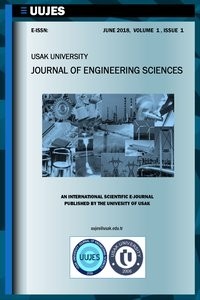EVALUATION OF FATIGUE PARAMETERS ON POLYMER MODIFIED BITUMENS
EVALUATION OF FATIGUE PARAMETERS ON POLYMER MODIFIED BITUMENS
Modification, polymer, polymer modified bitumen, fatigue parameter, elastomers, plastomers polyethylene,
___
- 1. Bull AL and Vonk WC. Thermoplastic rubber/bitumen blends for roof and road. London: Shell International Petroleum Company Publishing, 1984.
- 2. Gedeon E, Nicolas C, Achard C and Rogalski M. Characterization of aggregation processes in crude oils using differential scanning calorimetry. Energy & Fuels, 2005; 19: 1297-1302.
- 3. Redelius P and Soenen H. Bitumen chemistry and performance. Fuel, 2015;.140: 34-43. 4. Ali AH, Mashaan NS and Karim MR. Investigations of physical and rheological properties of aged rubberised bitumen. Advances in Materials Science and Engineering, 2013; 2: 1-8.
- 5. Asphalt Institute. Performance graded asphalt binder specification and testing. Lexington: Asphalt Institute, 2003.
- 6. Butt A, Jelagin D, Tasdemir Y and Birgisson B. The effect of wax modification on the performance of mastic asphalt. Journal of Pavement Research Technology, 2010; 3(2): 85-95.
- 7. Feng Z, Yu J and Wu S. Rheological evaluation of bitumen containing different ultraviolet absorbers. Construction and Building Materials, 2012;.29: 591-596. 8. Rusbintardjo G, Hainin MR and Yusoff NIM. Fundamental and rheological properties of oil palm fruit ash modified bitumen. Construction and Building Materials, 2013; 49: 702-711.
- 9. Brasileiro LL, Moreno-Navarro F, Martinez RT, Sol-Anchez M, Matos JME and Rubio-Gamez MC. Study of the feasability of producing modified asphalt bitumens using flakes made from recycled polymers. Construction and Building Materials, 2019; 208: 269-282.
- 10. Schaur A, Unterberger S and Lackner R. Impact of molecular structure of SBS on thermomechanical properties of polymer modified bitumen. European Polymer Journal, 2017; 96: 256-265.
- 11. Bulatovic V O, Rek V and Markovic KJ. Effect of polymer modifiers on the properties of bitumen. Journal of Elastomers&Plastics, 2014; 46(5): 448-469.
- 12. Canestrari F, Graziani A, Pannunzio V and Bahia HU. Rheological properties of bituminous binders with synthetic wax. International Journal of Pavement Research and Technology, 2013; 6(1): 15-21.
- 13. Liu J, Yan K, You L, Ge D and Wang Z. Laboratory performance of warm mix asphalt binder containing polyphosphoric acid. Construction and Building Materials, 2016; 106; 218-227.
- Başlangıç: 2018
- Yayıncı: Uşak Üniversitesi
INVESTIGATION OF THE WATER ABSORPTION PROPERTIES OF PULTRUDED HYBRID COMPOSITE PROFILES
NUMERICAL SOLUTION TECHNIQUES FOR CURRENT AND VOLTAGE VARIABLES IN ELECTRICAL (RLC) CIRCUITS
Falade KAZEEM, Ayodele VİCTORİA
EVALUATION OF FATIGUE PARAMETERS ON POLYMER MODIFIED BITUMENS
Mg/Zn COMPOSITES PRODUCED BY MECHANICAL ALLOYING AND HOT PRESSING AND IN-VITRO BIODEGRADATION
Simay ERDİBİL, Serap CESUR, Rasim İPEK
Babatunde BOLASODUN, Ademola AGBELEYE, Richard DAY
COMPARISON OF CLASSIFIERS FOR THE RISK OF OBESITY PREDICTION AMONG HIGH SCHOOL STUDENTS
